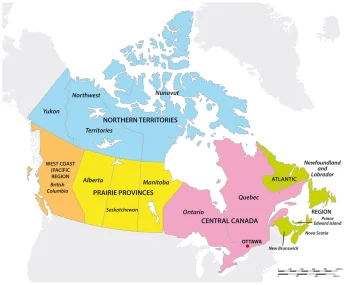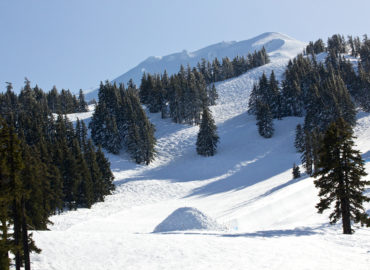Alright, first things first; let’s define what Prairie Provinces are. For all intents and purposes, Canada’s Prairie Provinces include those provinces on the eastern side of the Rocky Mountains but west of Ontario, including Alberta, Saskatchewan, and Manitoba.
In a nutshell, Canada has ten provinces and three territories. The provinces include Alberta, British Columbia, Manitoba, New Brunswick, Newfoundland and Labrador, Nova Scotia, Ontario, Prince Edward Island, Quebec, and Saskatchewan. The well-known capital city of Victoria is located in the Canadian province of British Columbia, on the southern tip of Vancouver Island off Canada’s Pacific coast (within the Northwest Territory).
The three territories of Canada include the Northwest Territories, Nunavut, and the Yukon Territory. We’ll discuss the difference in more detail later. They are also a significant source of petroleum, potash, and natural gas in Canada. The Great Plains in the United States and the Prairies in Canada have some of the most valuable prairies, where some of the world’s most important crops are growing.
For some time, I have wondered, besides the United States and Canada, if other countries are united but also autonomous at the same time. It turns out there are many other countries!
For example, according to the World Population Review, “Mexico is comprised of 31 states and the federal capital district of Mexico City. Each state in Mexico has its own congress and constitution and can make its own laws so long as they do not contradict the laws of the nation. This is very similar to the structure of the United States,”. I knew about our Northern neighbors but had no idea our neighbors south of the border had states as well. I have even been to Mexico twice; once, I went to the East Coast in Playa del Carmen, and another time, on the west coast, to Zihuantanejo! How could I have not known this?
Here’s a brief list of some other countries:
- Australia has six states
- Brazil has twenty-six states
- Mexico has thirty-one states
- India has twenty-eight states
- Canada has ten provinces and three territories
- China has twenty-three provinces
- Japan is divided into forty-seven prefectures
- France has eighteen regions
- Italy has twenty regions
- Russia is divided into twenty-two republics
- Spain has seventeen communities
- Germany has sixteen states, also called Bundesländer, or simply Länder (“states” in German)
What are the five regions of Canada?
In the United States, we, too have regions. Canada has provinces like our states, territories as our Puerto Rico, and regions such as our Midwest, East Coast, South and West Coast. From Canada’s official website, “Canada includes many different geographical areas and five distinct regions.
- The Atlantic Provinces
- Central Canada
- The Prairie Provinces
- The West Coast
- The Northern Territories,”.
While researching this information, I found that the United States has more territories than I initially thought. The U.S. Department of the Interior notes the following about our territories, “Insular Areas of the United States and Freely Associated States:
- American Samoa
- Guam
- Republic of the Marshall Islands
- Federated States of Micronesia
- Commonwealth of the Northern Mariana Islands
- Republic of Palau
- Puerto Rico
- U.S. Virgin Islands,”.
What is a region?
Now, let’s go back a bit and define what a region is precisely, whether it is in Canada, the United States, or Mexico. National Geographic Society defines it as, “A region is an area of land that has common features. A region can be defined by natural or artificial features. Language, government, or religion can define a region, as can forests, wildlife, or climate. A common way of referring to regions in the United States is grouping them into 5 regions according to their geographic position on the continent: the Northeast, Southwest, West, Southeast, and Midwest. Geographers who study regions may also find other physical or cultural similarities or differences between these areas,”.
The Prairie Provinces’ region is also known for its regional attributes, such as its vibrant cultural heritage and unique landscapes. Alberta, for instance, is famous for the Calgary Stampede, an annual rodeo, exhibition, and festival that celebrates the province’s deep roots in ranching. In addition to its cultural events, Alberta boasts breathtaking landscapes like Banff and Jasper National Parks, which attract tourists from around the globe.
Saskatchewan, often referred to as the Land of Living Skies, is known for its flatlands. Still, it’s a province teeming with historical sites and beautiful lakes, such as Waskesiu Lake in Prince Albert National Park.
Manitoba, on the other hand, combines natural beauty with a rich cultural scene. Winnipeg, its capital, offers cultural diversions, including the renowned Royal Winnipeg Ballet and the Canadian Museum for Human Rights, which is the first museum solely dedicated to the evolution, celebration, and future of human rights.
Communities in these regions have historically faced harsh weather conditions, yet they remain close-knit and welcoming, a melting pot for many immigrant communities, each bringing their traditions and blending seamlessly into the Canadian mosaic.
Looking at these provinces from an economic perspective, they stand as pillars of Canada’s economy. The extraction and export of resources like petroleum, potash, and natural gas are vital to the national economy, but there’s also a strong push towards sustainable practices and diversification, aiming to ensure long-term environmental health and economic stability.
In a global context, regions like the Prairie Provinces highlight the importance of understanding geopolitical and cultural landscapes. Just as the Prairie Provinces are integral to Canada’s identity and economy, regions and states within other nations contribute significantly to the fabric of their respective countries.
For example, the United States Midwest region, specifically here in Michigan, known as the Motor City capital of the world, obviously has an enormous economic impact on all the regions across fifty states. Michigan’s robust automotive production and sales drive job creation, technological advancements, and supply chain demands, effectively stimulating economic growth nationwide.
The interplay between geography, culture, and economics within these regions offers a deeper understanding of how nations function and thrive, underscoring the significance of both unity and diversity in shaping our world.
What are the Prairie Provinces?
In conclusion, the Prairie Provinces are on the west coast of Canada but east of the Rocky Mountain range. They are a significant source of petroleum, potash, and natural gas in Canada. The Great Plains in the United States and the Prairies in Canada have some of the most valuable prairies, where some of the world’s most important crops are growing.





